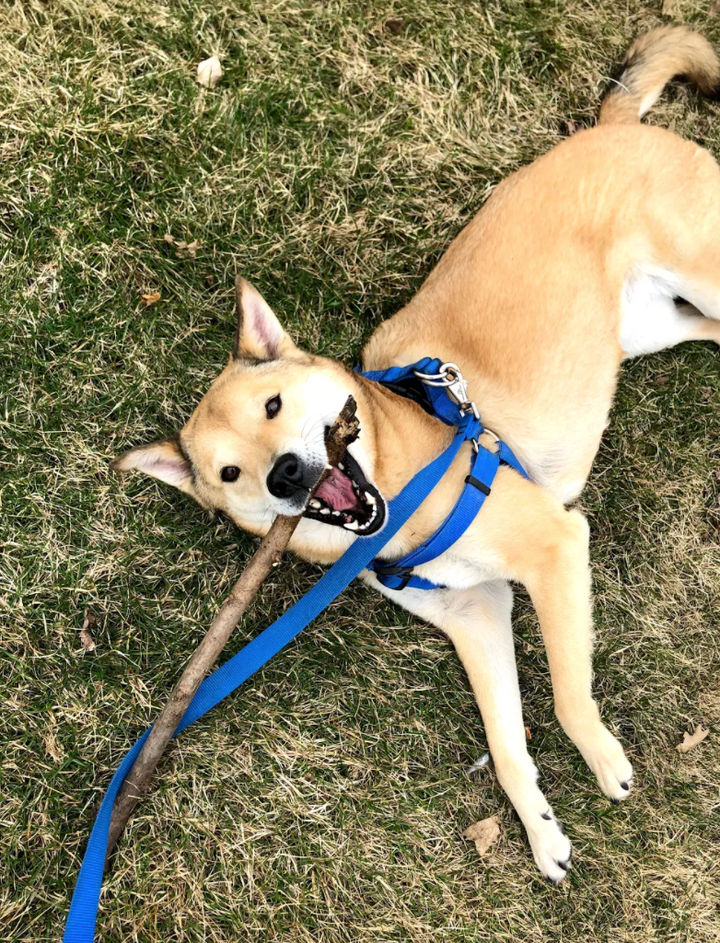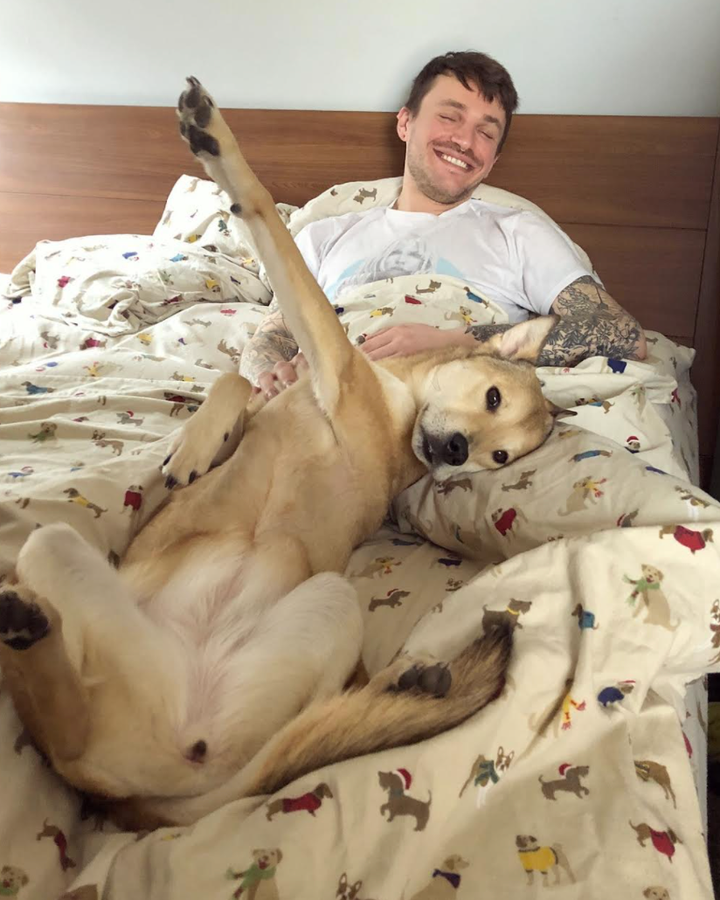
For six years I shared my life, on- and offline, with Tuna.
In 2014, after coming across her picture on a website where animal rescues list dogs in need of a home, I showed her to my boyfriend Alex. “We’ll see,” he said. A week or two later, the rescue was hosting a pop-up event at a chain pet supply store, so we went to go see her.
Alex wasn’t convinced until we met her offline, but I was sure the moment I saw her picture — especially her cartoon-glossy eyes, one a bit more closed than the other (a harbinger of future eye problems). I knew right away that Tuna (though that wasn’t her name then) was the dog I wanted to bring home.
Tuna, however, shared my boyfriend’s hesitance. Not specifically about us, but about everything. I think that’s why I was drawn to her ― it wasn’t her eyes, but what I saw in them. They reflected so much of my own anxiety, my fears about almost everything.
In our first months together, I patiently tried to teach her to become less afraid, more sure of herself and, with this increased confidence, more herself. As I coaxed her down a staircase that scared her, placing a treat on each step and showering her in ear-scratches at the end of a successful descent, I had no idea that I would end up needing her to do the same for me. I didn’t know then that she would help me find myself, too — or how big a role the internet would play in what our relationship would become.
For our first few years together, I only posted photos of Tuna occasionally. I kept my social media dispatches largely focused on professional updates, just as I had for most of my 20s. But then my life fell apart. My relationship came undone, the job that I’d considered my career summit ended, and Tuna and I moved back to my home state after nearly a decade living far away. Years of financial instability, career uncertainty, and health challenges followed, uprooting my sense of who I was and what gave my life meaning — and, along with it, the online “brand” that had developed around my career as a writer and activist.
As the brand fell away, the boundaries around what I “should” or “shouldn’t” share online, a question I’d fretted over for years, went with it. I started posting more about my life as it was, rather than worrying about how it should appear.
This coincided with a shift in my relationship with Tuna. Living alone, with me working from the tiny studio apartment we shared, Tuna and I became inseparable. If I went to a friend’s house, she usually came along (often at their insistence). We spent hours on walks every day, even on the coldest days of Minnesota winter. And when one of my best friends died by suicide last December, Tuna — usually more aloof than the average dog — snuggled me every night and, when I inevitably couldn’t sleep, got up and walked with me through the dark streets of Minneapolis at four in the morning.
As we grew closer, she became so much of what I shared online — everyday Instagram stories of her chewing on sticks or sleeping with one paw in the air, but also bigger personal and professional updates, like a photo of her posing with the advance copies of my second book.
Tuna worked her way into more and more of my social media output, and online strangers started expressing how much they cared for her and about her. Seemingly mundane Tuna posts — photos of her stalking squirrels, or videos of her standing on her hind legs so she could see the baristas behind the counter of our neighbourhood coffee shop — started getting more responses than just about anything else I shared.
Her online popularity underscored something that grew clearer the closer we became: Tuna wasn’t really my dog. Or rather, she wasn’t only mine. She belonged to herself, and to a community. This community was made up of the employees at the neighbourhood coffee shop, meat market, and hardware store, who all spoiled her so much that she insisted we stop at each one multiple times a day; the friends who watched her when I traveled for work, whom she loved so much that she would tug me in the direction of their apartments on our walks; and a group of people who had never even met her, who knew her only through my posts on social media.
This last community, the online one, was so much larger than I even knew, in part because of something that happened just earlier this year. While she’d had a doting following for years, Tuna’s moderate online presence reached new heights when a video of her appearing to watch one of the Democratic presidential primary debates (and wagging her tail as Sen. Bernie Sanders spoke) went viral. This video was viewed nearly a million times, and soon Tuna began appearing in memes and on political T-shirts. Journalists asked about her, and eventually, incredibly, even the Sanders campaign itself reached out to set up a meeting between Tuna and Jane Sanders (I was her plus-one, but all eyes were obviously on Tuna in that meeting). She even got her own fancam.
There are countless cute dogs online, but even before Tuna went viral, people interacted with her posts in a way that felt different to me. They seemed invested in her life, her happiness, and our relationship. But I didn’t know how true that was until one of the worst days of my life.
Less than six months after her biggest viral moment yet, at six-years-old, Tuna died suddenly. One afternoon in July she had a seizure, her first ever, and in just over 24 hours went from seemingly fine to dying in my arms. My sweet girl — who had grown from a skittish little lump of fur into a remarkable creature with a mind of her own, who could command the attention of a busy coffee shop or a crowded Twitter timeline — was reduced to lying limply on her side beneath a Christmas-themed fleece blanket provided by the animal hospital, her nose dry, her breathing rapid and shallow, those glassy eyes dulled and faintly opening only when I whispered to her: This will be over soon. I’m so sorry. I love you so much. Thank you for changing my life.
The next morning, after maybe two hours of sleep, I posted a couple of photos and a brief caption sharing what had happened. I was in shock, unsure how to express what I was feeling, but felt I should say something. I had shared so much of her life, it seemed wrong not to say something about her death.
I didn’t expect what I got ― 10,000 likes and hundreds of replies to the first tweet alone, and more on others I posted later. It wasn’t the numbers that struck me, but the intensity of the response. The emotion behind it. It was so much more than comments: People were creating art and recording music celebrating Tuna’s life, sharing memories of her, expressing how sad they were. As I absorbed the shock of losing her, online strangers memorialised and grieved with me.
How was it that so many people who had never even met her were lighting candles for her, holding toasts with their loved ones in her honor, even talking to their therapists about her? Though Tuna never knew about them — people always remarked with a laugh that she had no clue she was famous — in death it became clear how real the love of her online community was.
People often suggest that the connections we forge online aren’t real, or are at least less real than those we make offline, just as they suggest that our relationships with dogs are somehow less significant. But I think how we describe our relationships and contexts informs how we treat them, and helps define what’s possible of them.
If we treat our digital lives, and the connections we make through them, as less real, then they will be. If we treat a relationship with a dog as less real, that dog will be nothing more than an accessory, decor for our homes or Instagram feeds. But I’ve found that some of my greatest connections and relationships have been forged online, and that one of the defining relationships of my life has been with a beautiful dog with whom I shared my life and my online identity.
For years, friends suggested I make Tuna her own social media profile — in other words, that I give her a clearly defined “brand” like the one I once had. Sincerely no offence to people who do this, some of whom I know and love very much, but I sometimes find those profiles a bit corny. I’d say that was why when asked, but the truth is that I saw our identities as inseparable.

In the years following the end of the relationship during which I adopted her, I had to figure out who I was in a new life. Tuna helped me find it, and we became something new together. A large part of that something was forged online. Now I have to figure out who I am without her, what new thing I am. It’s work I’m still doing online: In the months since her death, my feed has included a steady stream of Tuna videos, photos and memories. The grief I feel over her absence is so large, I need to put it in different places ― and so I put some of it online, where so much of her community is.
I don’t know if I’ll ever fully understand why Tuna connected with so many people. My friend JP says it’s because she had an otherworldliness to her, that she sat between the real and the unreal. At times, this is what digital life feels like to me, too: a space between the real and unreal. It’s not quite like “real” (or offline) life, but it’s a place where previously inconceivable modes of being and belonging are possible, where we can become real in new ways. This is never clearer to me than when I remember that the internet is where I first found Tuna, and where, in her posts and her online community, she still lives on.
The internet can help us better understand ourselves, like Tuna did for me, and forge real connections, like the internet did with Tuna. We just need to be open to possibility, to the idea that “real” life can happen online, too. Akin to what Tuna and I did for one another, it is an act of moving beyond hesitation and letting your guard down. Of seeing and being seen, and becoming more fully yourself in the process.
I don’t really know why Tuna went viral in both life and death. It was probably just invisible algorithms pulling strings. But I like to think it’s at least partially because there was something so real about her that people couldn’t look away. As I scroll through the thousands of tweets and Instagram stories and Facebook posts that I and hundreds of strangers made about Tuna over the years ― posts that connected us to one another, and to so many other people — I can’t look away, either. For now, I don’t want to.
Chris Stedman is the author of ”IRL: Finding Realness, Meaning, and Belonging in Our Digital Lives,” and teaches in the department of religion and philosophy at Augsburg University in Minneapolis. This article first appeared on HuffPost Personal.